Effective Team Work and Communication Assessment 1
VerifiedAdded on 2023/06/18
|10
|3015
|85
AI Summary
This report sheds light on various models and methods of effective team work and communication, including linear model, transactional model, Shannon and Weaver model, Schramm model, and Berlo’s model. It also highlights the importance of effective communication and the problems that can be faced due to poor communication.
Contribute Materials
Your contribution can guide someone’s learning journey. Share your
documents today.
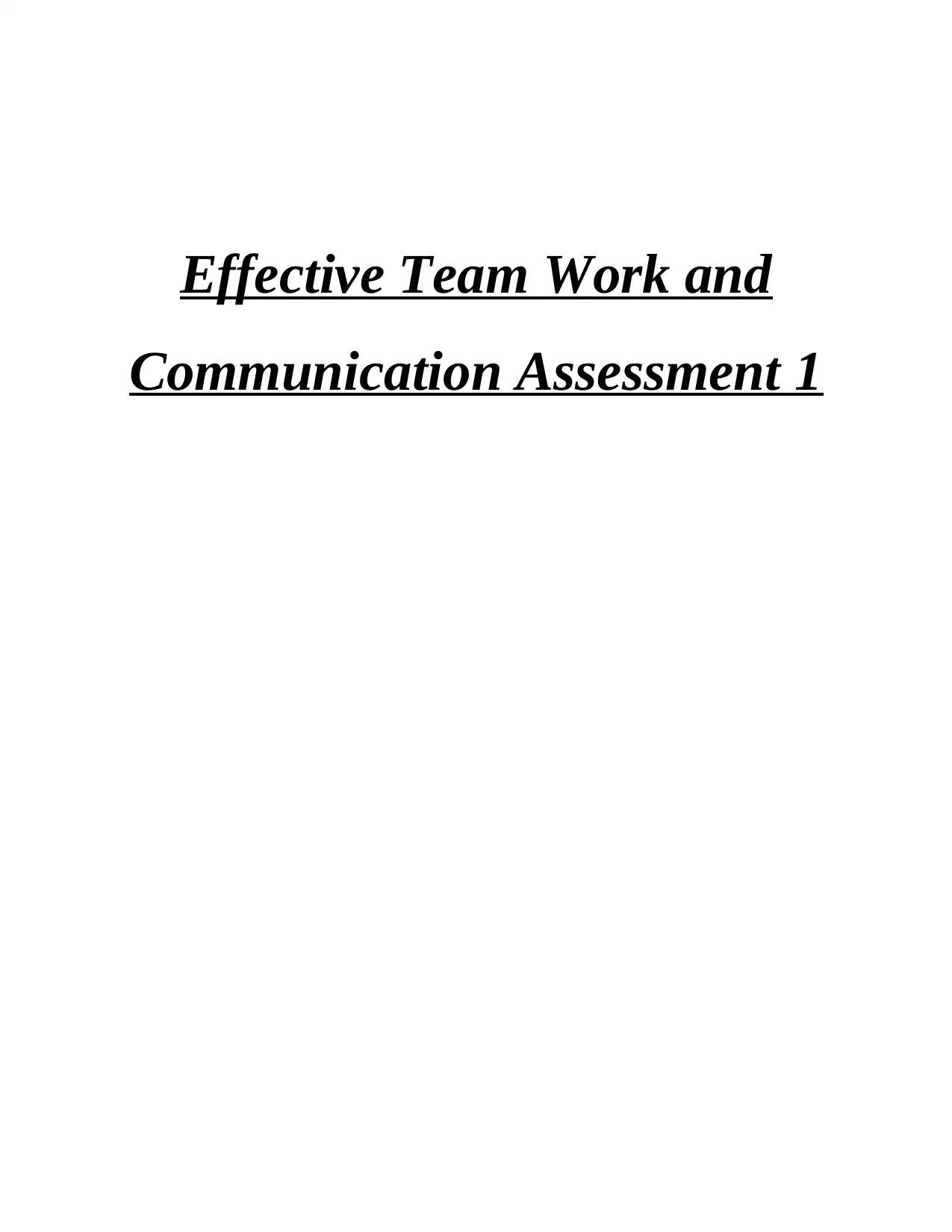
Effective Team Work and
Communication Assessment 1
Communication Assessment 1
Secure Best Marks with AI Grader
Need help grading? Try our AI Grader for instant feedback on your assignments.
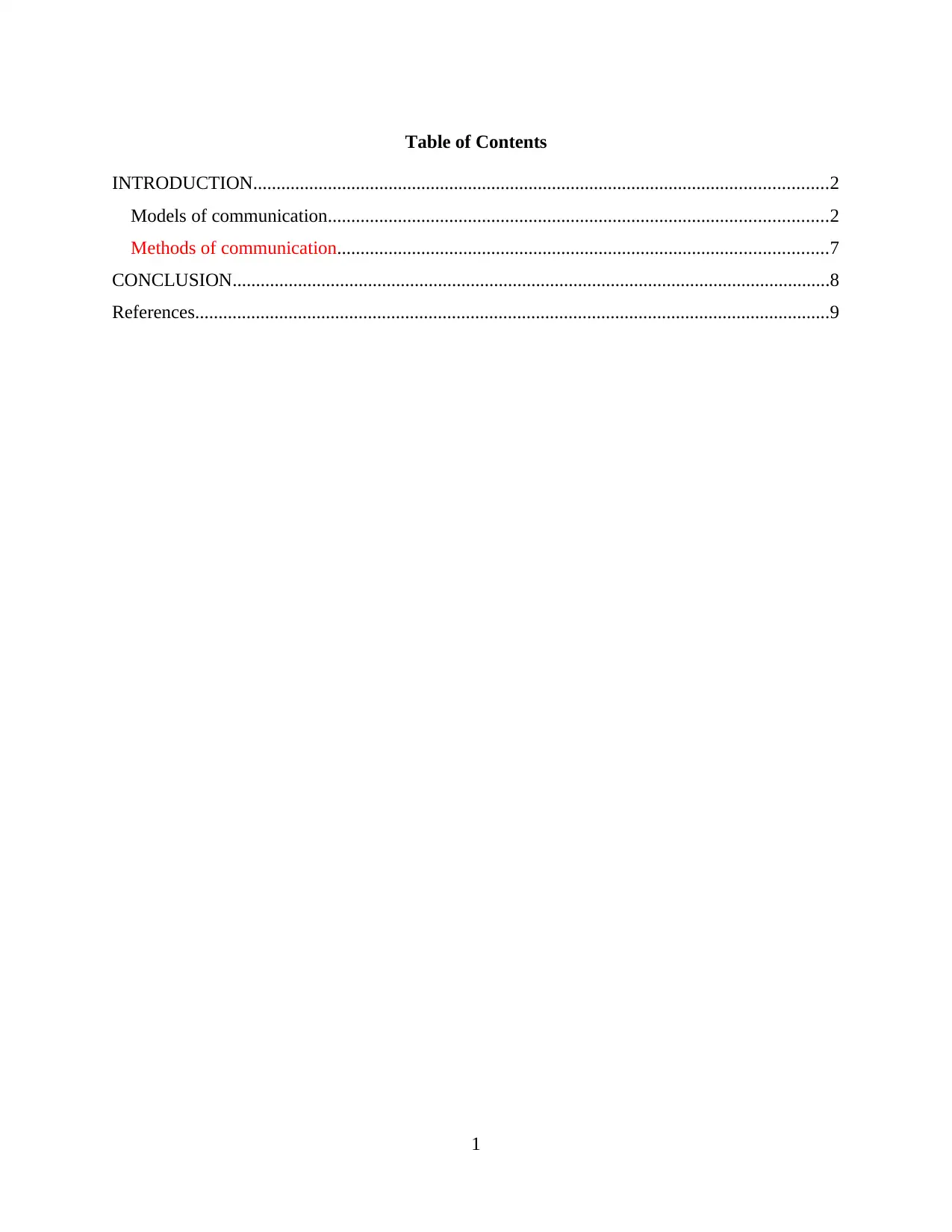
Table of Contents
INTRODUCTION...........................................................................................................................2
Models of communication...........................................................................................................2
Methods of communication.........................................................................................................7
CONCLUSION................................................................................................................................8
References........................................................................................................................................9
1
INTRODUCTION...........................................................................................................................2
Models of communication...........................................................................................................2
Methods of communication.........................................................................................................7
CONCLUSION................................................................................................................................8
References........................................................................................................................................9
1
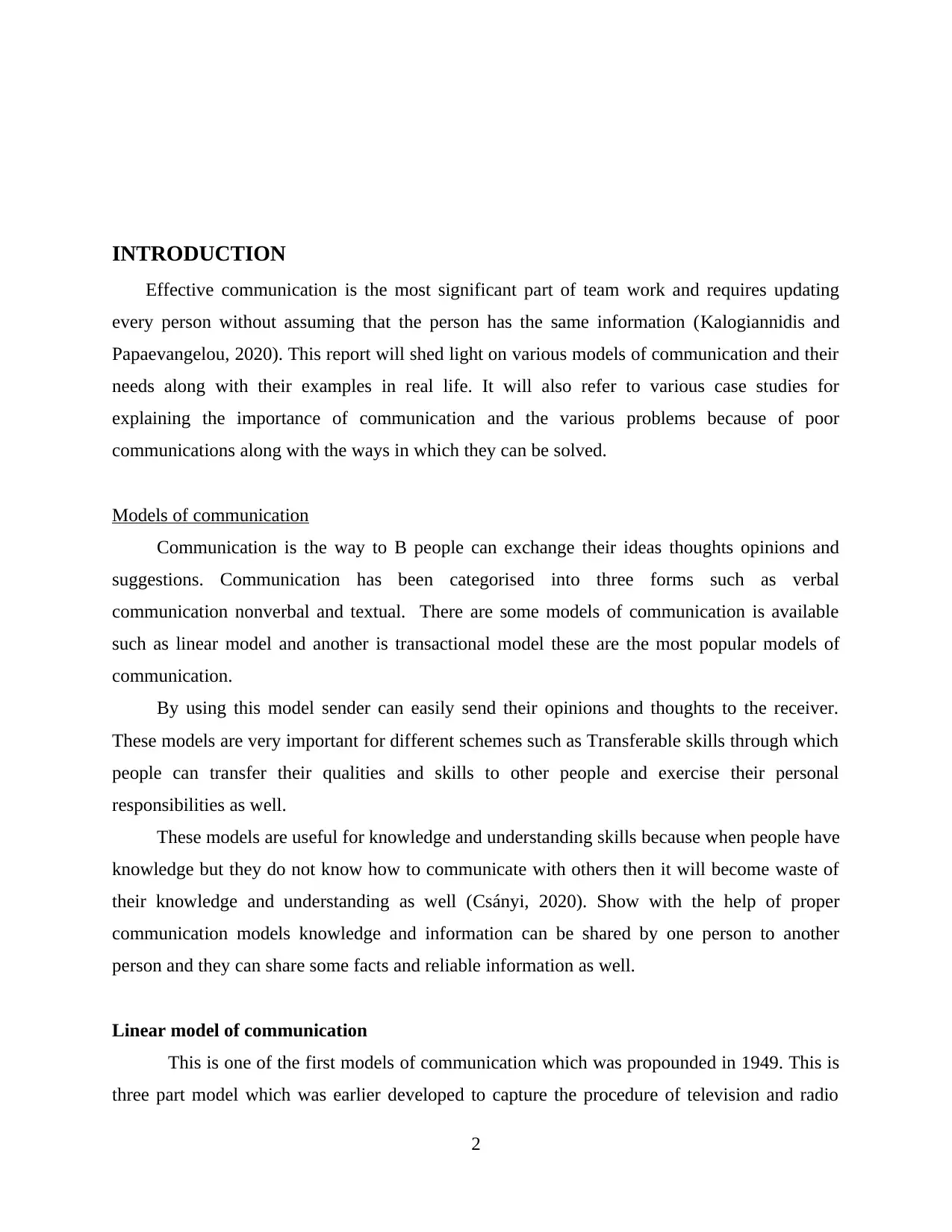
INTRODUCTION
Effective communication is the most significant part of team work and requires updating
every person without assuming that the person has the same information (Kalogiannidis and
Papaevangelou, 2020). This report will shed light on various models of communication and their
needs along with their examples in real life. It will also refer to various case studies for
explaining the importance of communication and the various problems because of poor
communications along with the ways in which they can be solved.
Models of communication
Communication is the way to B people can exchange their ideas thoughts opinions and
suggestions. Communication has been categorised into three forms such as verbal
communication nonverbal and textual. There are some models of communication is available
such as linear model and another is transactional model these are the most popular models of
communication.
By using this model sender can easily send their opinions and thoughts to the receiver.
These models are very important for different schemes such as Transferable skills through which
people can transfer their qualities and skills to other people and exercise their personal
responsibilities as well.
These models are useful for knowledge and understanding skills because when people have
knowledge but they do not know how to communicate with others then it will become waste of
their knowledge and understanding as well (Csányi, 2020). Show with the help of proper
communication models knowledge and information can be shared by one person to another
person and they can share some facts and reliable information as well.
Linear model of communication
This is one of the first models of communication which was propounded in 1949. This is
three part model which was earlier developed to capture the procedure of television and radio
2
Effective communication is the most significant part of team work and requires updating
every person without assuming that the person has the same information (Kalogiannidis and
Papaevangelou, 2020). This report will shed light on various models of communication and their
needs along with their examples in real life. It will also refer to various case studies for
explaining the importance of communication and the various problems because of poor
communications along with the ways in which they can be solved.
Models of communication
Communication is the way to B people can exchange their ideas thoughts opinions and
suggestions. Communication has been categorised into three forms such as verbal
communication nonverbal and textual. There are some models of communication is available
such as linear model and another is transactional model these are the most popular models of
communication.
By using this model sender can easily send their opinions and thoughts to the receiver.
These models are very important for different schemes such as Transferable skills through which
people can transfer their qualities and skills to other people and exercise their personal
responsibilities as well.
These models are useful for knowledge and understanding skills because when people have
knowledge but they do not know how to communicate with others then it will become waste of
their knowledge and understanding as well (Csányi, 2020). Show with the help of proper
communication models knowledge and information can be shared by one person to another
person and they can share some facts and reliable information as well.
Linear model of communication
This is one of the first models of communication which was propounded in 1949. This is
three part model which was earlier developed to capture the procedure of television and radio
2
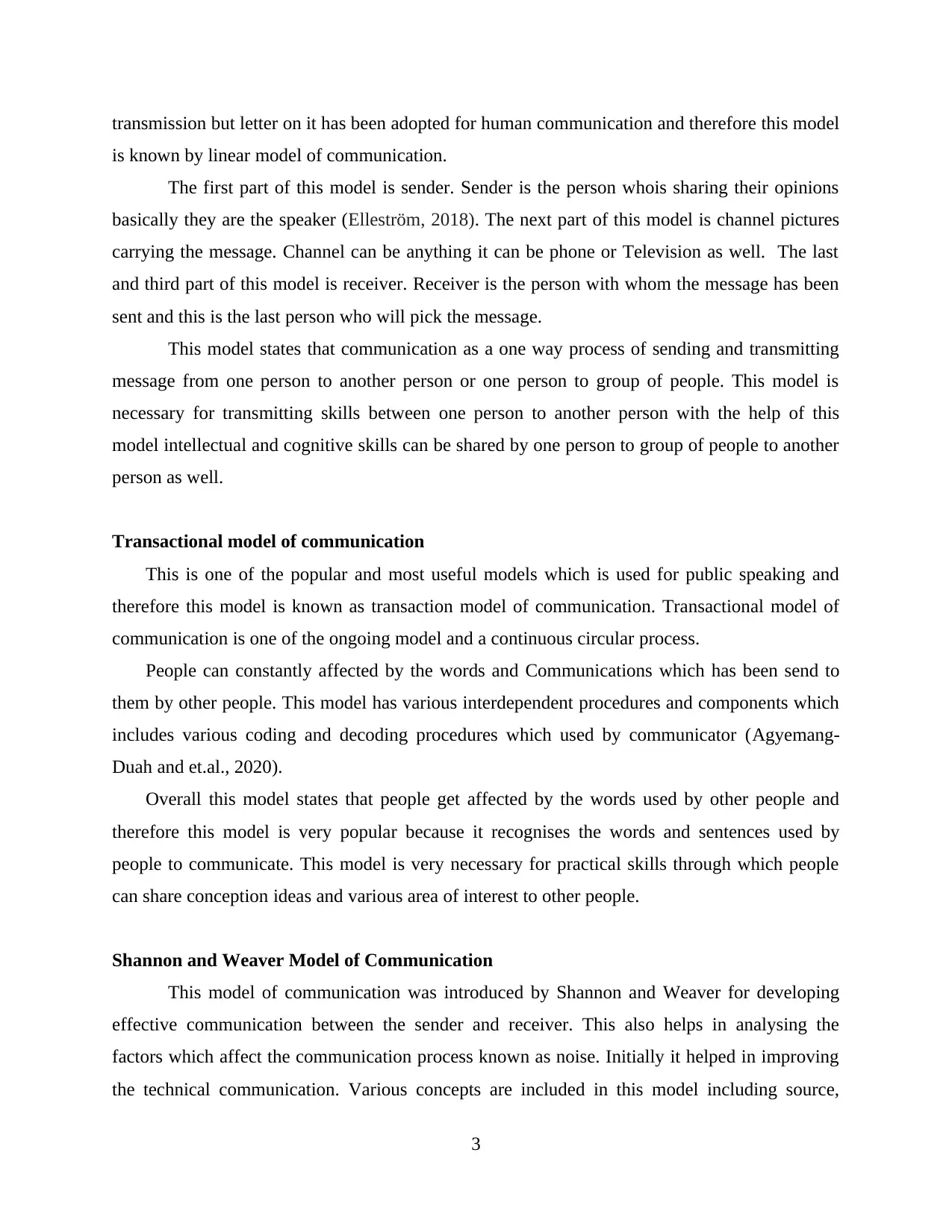
transmission but letter on it has been adopted for human communication and therefore this model
is known by linear model of communication.
The first part of this model is sender. Sender is the person whois sharing their opinions
basically they are the speaker (Elleström, 2018). The next part of this model is channel pictures
carrying the message. Channel can be anything it can be phone or Television as well. The last
and third part of this model is receiver. Receiver is the person with whom the message has been
sent and this is the last person who will pick the message.
This model states that communication as a one way process of sending and transmitting
message from one person to another person or one person to group of people. This model is
necessary for transmitting skills between one person to another person with the help of this
model intellectual and cognitive skills can be shared by one person to group of people to another
person as well.
Transactional model of communication
This is one of the popular and most useful models which is used for public speaking and
therefore this model is known as transaction model of communication. Transactional model of
communication is one of the ongoing model and a continuous circular process.
People can constantly affected by the words and Communications which has been send to
them by other people. This model has various interdependent procedures and components which
includes various coding and decoding procedures which used by communicator (Agyemang-
Duah and et.al., 2020).
Overall this model states that people get affected by the words used by other people and
therefore this model is very popular because it recognises the words and sentences used by
people to communicate. This model is very necessary for practical skills through which people
can share conception ideas and various area of interest to other people.
Shannon and Weaver Model of Communication
This model of communication was introduced by Shannon and Weaver for developing
effective communication between the sender and receiver. This also helps in analysing the
factors which affect the communication process known as noise. Initially it helped in improving
the technical communication. Various concepts are included in this model including source,
3
is known by linear model of communication.
The first part of this model is sender. Sender is the person whois sharing their opinions
basically they are the speaker (Elleström, 2018). The next part of this model is channel pictures
carrying the message. Channel can be anything it can be phone or Television as well. The last
and third part of this model is receiver. Receiver is the person with whom the message has been
sent and this is the last person who will pick the message.
This model states that communication as a one way process of sending and transmitting
message from one person to another person or one person to group of people. This model is
necessary for transmitting skills between one person to another person with the help of this
model intellectual and cognitive skills can be shared by one person to group of people to another
person as well.
Transactional model of communication
This is one of the popular and most useful models which is used for public speaking and
therefore this model is known as transaction model of communication. Transactional model of
communication is one of the ongoing model and a continuous circular process.
People can constantly affected by the words and Communications which has been send to
them by other people. This model has various interdependent procedures and components which
includes various coding and decoding procedures which used by communicator (Agyemang-
Duah and et.al., 2020).
Overall this model states that people get affected by the words used by other people and
therefore this model is very popular because it recognises the words and sentences used by
people to communicate. This model is very necessary for practical skills through which people
can share conception ideas and various area of interest to other people.
Shannon and Weaver Model of Communication
This model of communication was introduced by Shannon and Weaver for developing
effective communication between the sender and receiver. This also helps in analysing the
factors which affect the communication process known as noise. Initially it helped in improving
the technical communication. Various concepts are included in this model including source,
3
Secure Best Marks with AI Grader
Need help grading? Try our AI Grader for instant feedback on your assignments.
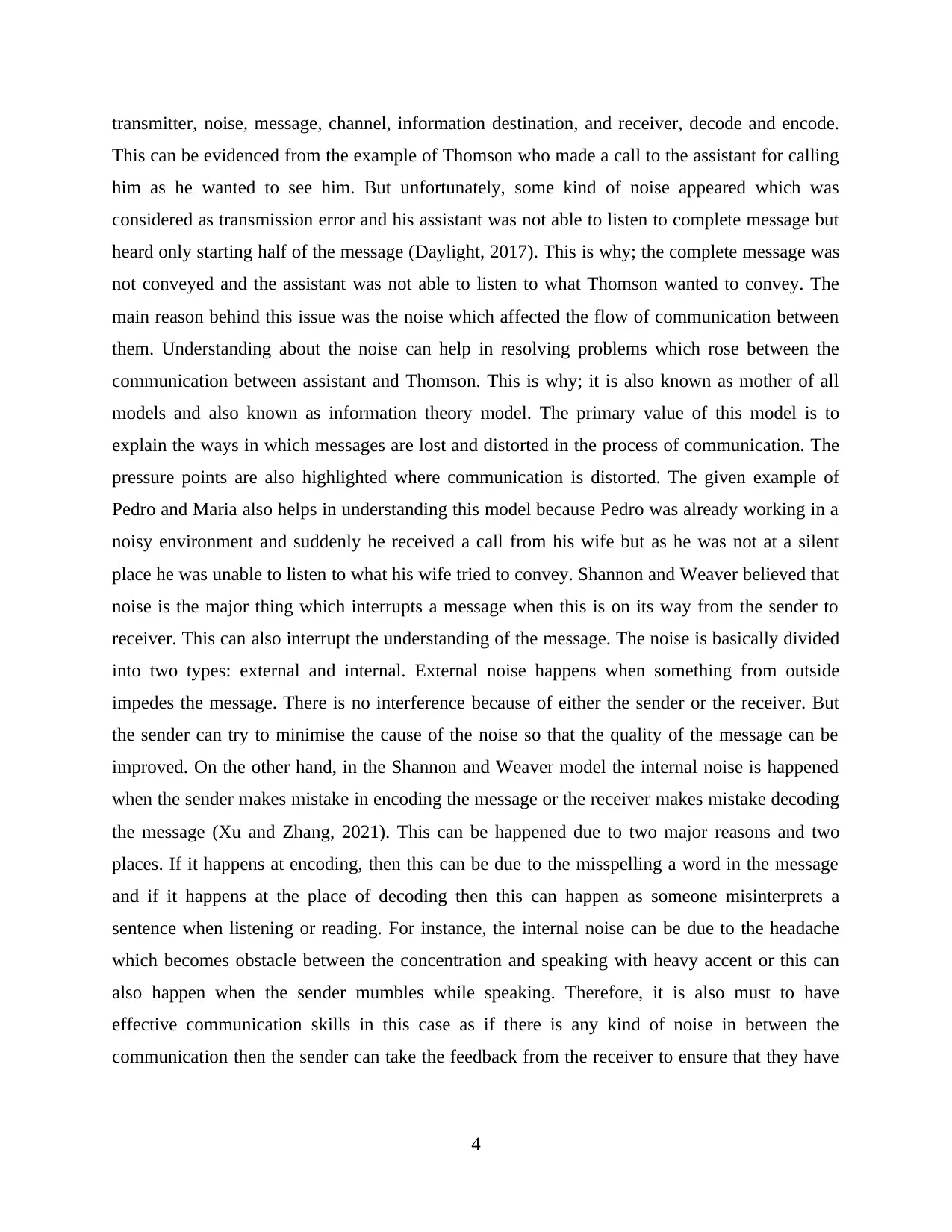
transmitter, noise, message, channel, information destination, and receiver, decode and encode.
This can be evidenced from the example of Thomson who made a call to the assistant for calling
him as he wanted to see him. But unfortunately, some kind of noise appeared which was
considered as transmission error and his assistant was not able to listen to complete message but
heard only starting half of the message (Daylight, 2017). This is why; the complete message was
not conveyed and the assistant was not able to listen to what Thomson wanted to convey. The
main reason behind this issue was the noise which affected the flow of communication between
them. Understanding about the noise can help in resolving problems which rose between the
communication between assistant and Thomson. This is why; it is also known as mother of all
models and also known as information theory model. The primary value of this model is to
explain the ways in which messages are lost and distorted in the process of communication. The
pressure points are also highlighted where communication is distorted. The given example of
Pedro and Maria also helps in understanding this model because Pedro was already working in a
noisy environment and suddenly he received a call from his wife but as he was not at a silent
place he was unable to listen to what his wife tried to convey. Shannon and Weaver believed that
noise is the major thing which interrupts a message when this is on its way from the sender to
receiver. This can also interrupt the understanding of the message. The noise is basically divided
into two types: external and internal. External noise happens when something from outside
impedes the message. There is no interference because of either the sender or the receiver. But
the sender can try to minimise the cause of the noise so that the quality of the message can be
improved. On the other hand, in the Shannon and Weaver model the internal noise is happened
when the sender makes mistake in encoding the message or the receiver makes mistake decoding
the message (Xu and Zhang, 2021). This can be happened due to two major reasons and two
places. If it happens at encoding, then this can be due to the misspelling a word in the message
and if it happens at the place of decoding then this can happen as someone misinterprets a
sentence when listening or reading. For instance, the internal noise can be due to the headache
which becomes obstacle between the concentration and speaking with heavy accent or this can
also happen when the sender mumbles while speaking. Therefore, it is also must to have
effective communication skills in this case as if there is any kind of noise in between the
communication then the sender can take the feedback from the receiver to ensure that they have
4
This can be evidenced from the example of Thomson who made a call to the assistant for calling
him as he wanted to see him. But unfortunately, some kind of noise appeared which was
considered as transmission error and his assistant was not able to listen to complete message but
heard only starting half of the message (Daylight, 2017). This is why; the complete message was
not conveyed and the assistant was not able to listen to what Thomson wanted to convey. The
main reason behind this issue was the noise which affected the flow of communication between
them. Understanding about the noise can help in resolving problems which rose between the
communication between assistant and Thomson. This is why; it is also known as mother of all
models and also known as information theory model. The primary value of this model is to
explain the ways in which messages are lost and distorted in the process of communication. The
pressure points are also highlighted where communication is distorted. The given example of
Pedro and Maria also helps in understanding this model because Pedro was already working in a
noisy environment and suddenly he received a call from his wife but as he was not at a silent
place he was unable to listen to what his wife tried to convey. Shannon and Weaver believed that
noise is the major thing which interrupts a message when this is on its way from the sender to
receiver. This can also interrupt the understanding of the message. The noise is basically divided
into two types: external and internal. External noise happens when something from outside
impedes the message. There is no interference because of either the sender or the receiver. But
the sender can try to minimise the cause of the noise so that the quality of the message can be
improved. On the other hand, in the Shannon and Weaver model the internal noise is happened
when the sender makes mistake in encoding the message or the receiver makes mistake decoding
the message (Xu and Zhang, 2021). This can be happened due to two major reasons and two
places. If it happens at encoding, then this can be due to the misspelling a word in the message
and if it happens at the place of decoding then this can happen as someone misinterprets a
sentence when listening or reading. For instance, the internal noise can be due to the headache
which becomes obstacle between the concentration and speaking with heavy accent or this can
also happen when the sender mumbles while speaking. Therefore, it is also must to have
effective communication skills in this case as if there is any kind of noise in between the
communication then the sender can take the feedback from the receiver to ensure that they have
4
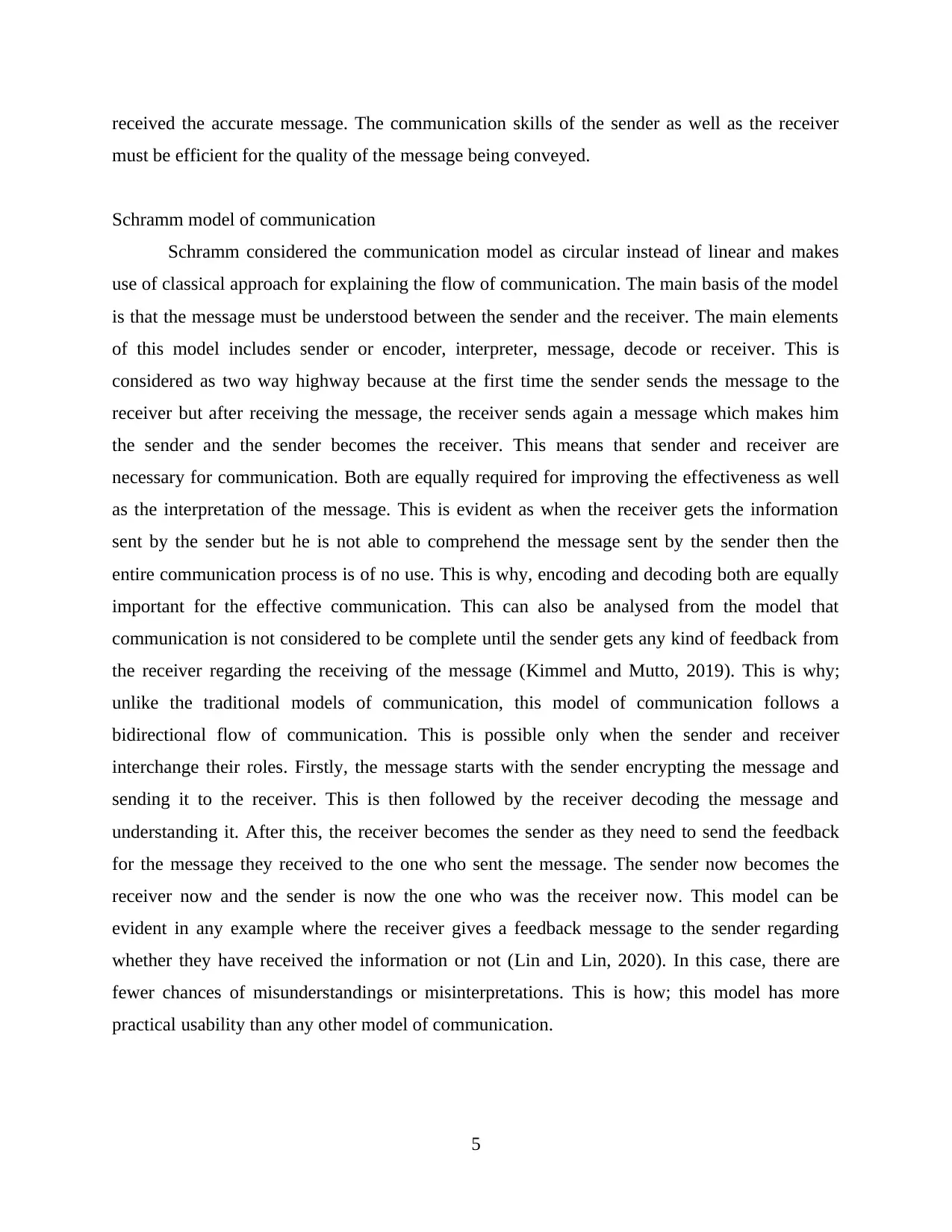
received the accurate message. The communication skills of the sender as well as the receiver
must be efficient for the quality of the message being conveyed.
Schramm model of communication
Schramm considered the communication model as circular instead of linear and makes
use of classical approach for explaining the flow of communication. The main basis of the model
is that the message must be understood between the sender and the receiver. The main elements
of this model includes sender or encoder, interpreter, message, decode or receiver. This is
considered as two way highway because at the first time the sender sends the message to the
receiver but after receiving the message, the receiver sends again a message which makes him
the sender and the sender becomes the receiver. This means that sender and receiver are
necessary for communication. Both are equally required for improving the effectiveness as well
as the interpretation of the message. This is evident as when the receiver gets the information
sent by the sender but he is not able to comprehend the message sent by the sender then the
entire communication process is of no use. This is why, encoding and decoding both are equally
important for the effective communication. This can also be analysed from the model that
communication is not considered to be complete until the sender gets any kind of feedback from
the receiver regarding the receiving of the message (Kimmel and Mutto, 2019). This is why;
unlike the traditional models of communication, this model of communication follows a
bidirectional flow of communication. This is possible only when the sender and receiver
interchange their roles. Firstly, the message starts with the sender encrypting the message and
sending it to the receiver. This is then followed by the receiver decoding the message and
understanding it. After this, the receiver becomes the sender as they need to send the feedback
for the message they received to the one who sent the message. The sender now becomes the
receiver now and the sender is now the one who was the receiver now. This model can be
evident in any example where the receiver gives a feedback message to the sender regarding
whether they have received the information or not (Lin and Lin, 2020). In this case, there are
fewer chances of misunderstandings or misinterpretations. This is how; this model has more
practical usability than any other model of communication.
5
must be efficient for the quality of the message being conveyed.
Schramm model of communication
Schramm considered the communication model as circular instead of linear and makes
use of classical approach for explaining the flow of communication. The main basis of the model
is that the message must be understood between the sender and the receiver. The main elements
of this model includes sender or encoder, interpreter, message, decode or receiver. This is
considered as two way highway because at the first time the sender sends the message to the
receiver but after receiving the message, the receiver sends again a message which makes him
the sender and the sender becomes the receiver. This means that sender and receiver are
necessary for communication. Both are equally required for improving the effectiveness as well
as the interpretation of the message. This is evident as when the receiver gets the information
sent by the sender but he is not able to comprehend the message sent by the sender then the
entire communication process is of no use. This is why, encoding and decoding both are equally
important for the effective communication. This can also be analysed from the model that
communication is not considered to be complete until the sender gets any kind of feedback from
the receiver regarding the receiving of the message (Kimmel and Mutto, 2019). This is why;
unlike the traditional models of communication, this model of communication follows a
bidirectional flow of communication. This is possible only when the sender and receiver
interchange their roles. Firstly, the message starts with the sender encrypting the message and
sending it to the receiver. This is then followed by the receiver decoding the message and
understanding it. After this, the receiver becomes the sender as they need to send the feedback
for the message they received to the one who sent the message. The sender now becomes the
receiver now and the sender is now the one who was the receiver now. This model can be
evident in any example where the receiver gives a feedback message to the sender regarding
whether they have received the information or not (Lin and Lin, 2020). In this case, there are
fewer chances of misunderstandings or misinterpretations. This is how; this model has more
practical usability than any other model of communication.
5
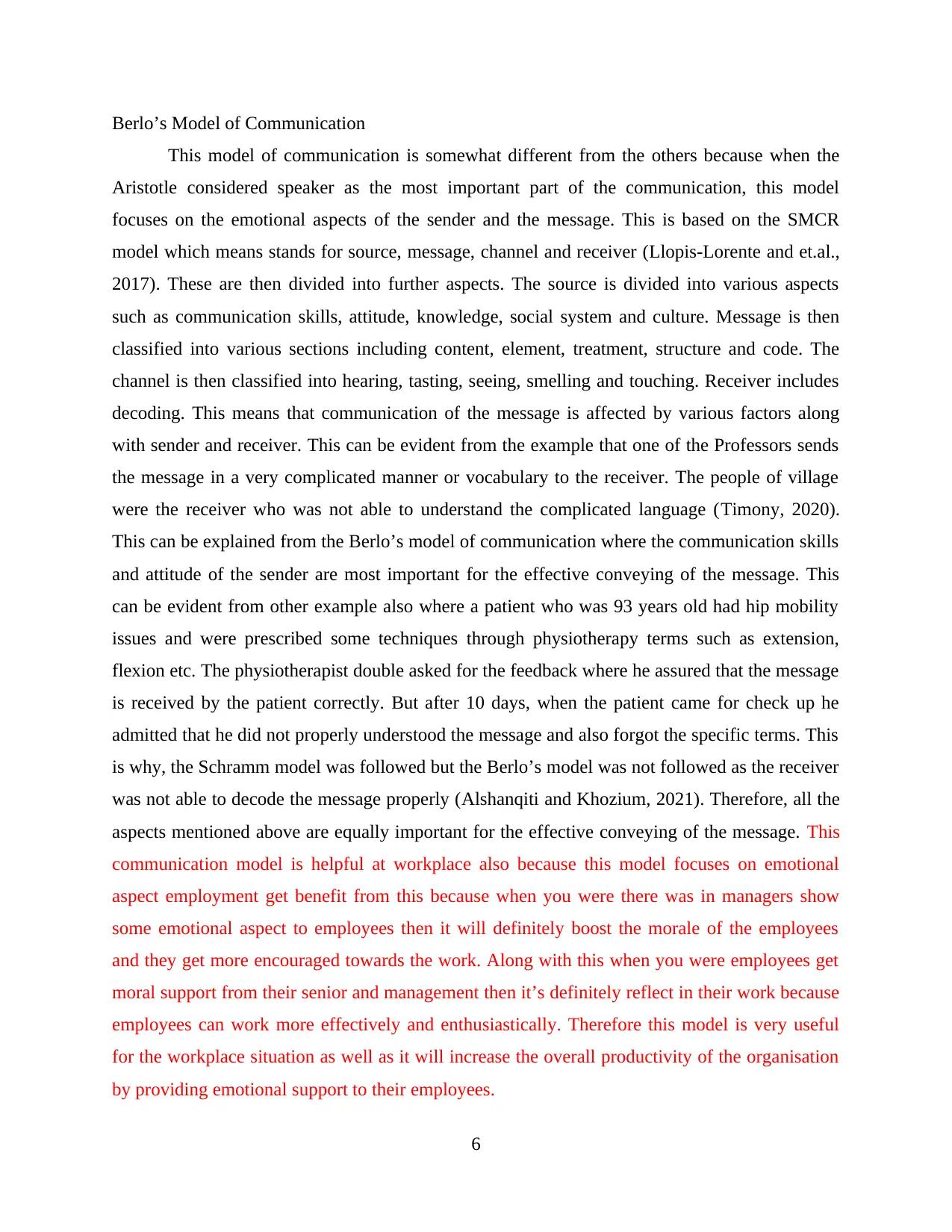
Berlo’s Model of Communication
This model of communication is somewhat different from the others because when the
Aristotle considered speaker as the most important part of the communication, this model
focuses on the emotional aspects of the sender and the message. This is based on the SMCR
model which means stands for source, message, channel and receiver (Llopis-Lorente and et.al.,
2017). These are then divided into further aspects. The source is divided into various aspects
such as communication skills, attitude, knowledge, social system and culture. Message is then
classified into various sections including content, element, treatment, structure and code. The
channel is then classified into hearing, tasting, seeing, smelling and touching. Receiver includes
decoding. This means that communication of the message is affected by various factors along
with sender and receiver. This can be evident from the example that one of the Professors sends
the message in a very complicated manner or vocabulary to the receiver. The people of village
were the receiver who was not able to understand the complicated language (Timony, 2020).
This can be explained from the Berlo’s model of communication where the communication skills
and attitude of the sender are most important for the effective conveying of the message. This
can be evident from other example also where a patient who was 93 years old had hip mobility
issues and were prescribed some techniques through physiotherapy terms such as extension,
flexion etc. The physiotherapist double asked for the feedback where he assured that the message
is received by the patient correctly. But after 10 days, when the patient came for check up he
admitted that he did not properly understood the message and also forgot the specific terms. This
is why, the Schramm model was followed but the Berlo’s model was not followed as the receiver
was not able to decode the message properly (Alshanqiti and Khozium, 2021). Therefore, all the
aspects mentioned above are equally important for the effective conveying of the message. This
communication model is helpful at workplace also because this model focuses on emotional
aspect employment get benefit from this because when you were there was in managers show
some emotional aspect to employees then it will definitely boost the morale of the employees
and they get more encouraged towards the work. Along with this when you were employees get
moral support from their senior and management then it’s definitely reflect in their work because
employees can work more effectively and enthusiastically. Therefore this model is very useful
for the workplace situation as well as it will increase the overall productivity of the organisation
by providing emotional support to their employees.
6
This model of communication is somewhat different from the others because when the
Aristotle considered speaker as the most important part of the communication, this model
focuses on the emotional aspects of the sender and the message. This is based on the SMCR
model which means stands for source, message, channel and receiver (Llopis-Lorente and et.al.,
2017). These are then divided into further aspects. The source is divided into various aspects
such as communication skills, attitude, knowledge, social system and culture. Message is then
classified into various sections including content, element, treatment, structure and code. The
channel is then classified into hearing, tasting, seeing, smelling and touching. Receiver includes
decoding. This means that communication of the message is affected by various factors along
with sender and receiver. This can be evident from the example that one of the Professors sends
the message in a very complicated manner or vocabulary to the receiver. The people of village
were the receiver who was not able to understand the complicated language (Timony, 2020).
This can be explained from the Berlo’s model of communication where the communication skills
and attitude of the sender are most important for the effective conveying of the message. This
can be evident from other example also where a patient who was 93 years old had hip mobility
issues and were prescribed some techniques through physiotherapy terms such as extension,
flexion etc. The physiotherapist double asked for the feedback where he assured that the message
is received by the patient correctly. But after 10 days, when the patient came for check up he
admitted that he did not properly understood the message and also forgot the specific terms. This
is why, the Schramm model was followed but the Berlo’s model was not followed as the receiver
was not able to decode the message properly (Alshanqiti and Khozium, 2021). Therefore, all the
aspects mentioned above are equally important for the effective conveying of the message. This
communication model is helpful at workplace also because this model focuses on emotional
aspect employment get benefit from this because when you were there was in managers show
some emotional aspect to employees then it will definitely boost the morale of the employees
and they get more encouraged towards the work. Along with this when you were employees get
moral support from their senior and management then it’s definitely reflect in their work because
employees can work more effectively and enthusiastically. Therefore this model is very useful
for the workplace situation as well as it will increase the overall productivity of the organisation
by providing emotional support to their employees.
6
Paraphrase This Document
Need a fresh take? Get an instant paraphrase of this document with our AI Paraphraser
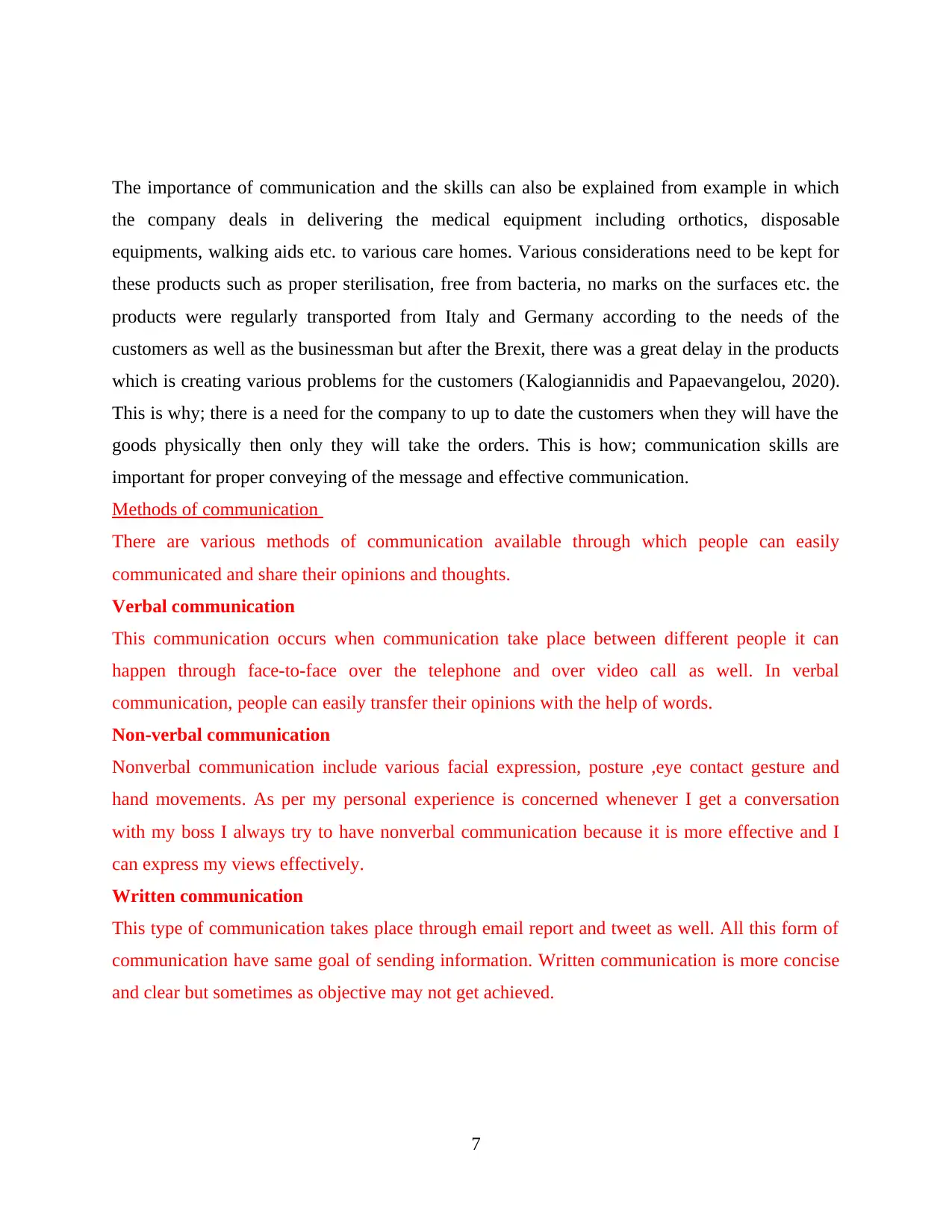
The importance of communication and the skills can also be explained from example in which
the company deals in delivering the medical equipment including orthotics, disposable
equipments, walking aids etc. to various care homes. Various considerations need to be kept for
these products such as proper sterilisation, free from bacteria, no marks on the surfaces etc. the
products were regularly transported from Italy and Germany according to the needs of the
customers as well as the businessman but after the Brexit, there was a great delay in the products
which is creating various problems for the customers (Kalogiannidis and Papaevangelou, 2020).
This is why; there is a need for the company to up to date the customers when they will have the
goods physically then only they will take the orders. This is how; communication skills are
important for proper conveying of the message and effective communication.
Methods of communication
There are various methods of communication available through which people can easily
communicated and share their opinions and thoughts.
Verbal communication
This communication occurs when communication take place between different people it can
happen through face-to-face over the telephone and over video call as well. In verbal
communication, people can easily transfer their opinions with the help of words.
Non-verbal communication
Nonverbal communication include various facial expression, posture ,eye contact gesture and
hand movements. As per my personal experience is concerned whenever I get a conversation
with my boss I always try to have nonverbal communication because it is more effective and I
can express my views effectively.
Written communication
This type of communication takes place through email report and tweet as well. All this form of
communication have same goal of sending information. Written communication is more concise
and clear but sometimes as objective may not get achieved.
7
the company deals in delivering the medical equipment including orthotics, disposable
equipments, walking aids etc. to various care homes. Various considerations need to be kept for
these products such as proper sterilisation, free from bacteria, no marks on the surfaces etc. the
products were regularly transported from Italy and Germany according to the needs of the
customers as well as the businessman but after the Brexit, there was a great delay in the products
which is creating various problems for the customers (Kalogiannidis and Papaevangelou, 2020).
This is why; there is a need for the company to up to date the customers when they will have the
goods physically then only they will take the orders. This is how; communication skills are
important for proper conveying of the message and effective communication.
Methods of communication
There are various methods of communication available through which people can easily
communicated and share their opinions and thoughts.
Verbal communication
This communication occurs when communication take place between different people it can
happen through face-to-face over the telephone and over video call as well. In verbal
communication, people can easily transfer their opinions with the help of words.
Non-verbal communication
Nonverbal communication include various facial expression, posture ,eye contact gesture and
hand movements. As per my personal experience is concerned whenever I get a conversation
with my boss I always try to have nonverbal communication because it is more effective and I
can express my views effectively.
Written communication
This type of communication takes place through email report and tweet as well. All this form of
communication have same goal of sending information. Written communication is more concise
and clear but sometimes as objective may not get achieved.
7
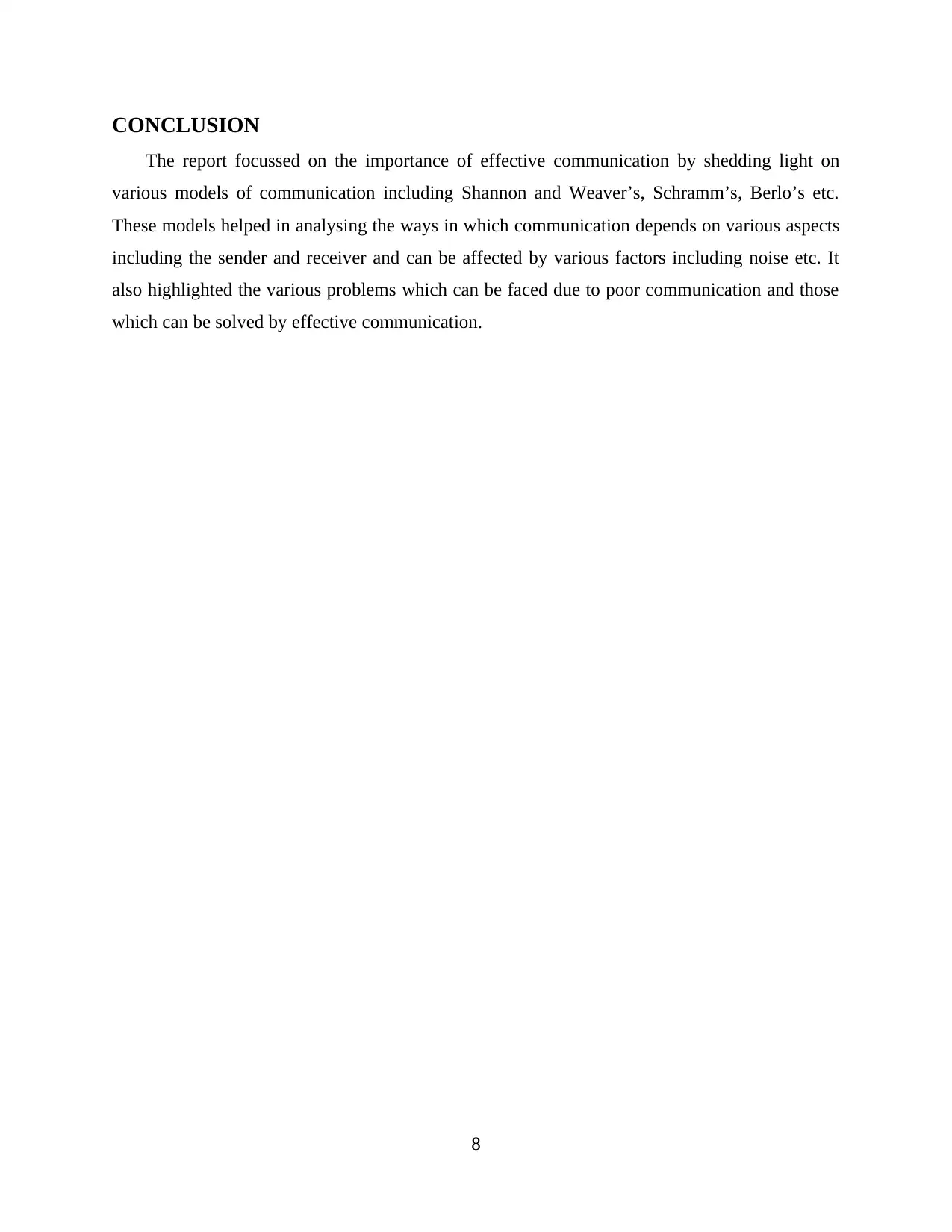
CONCLUSION
The report focussed on the importance of effective communication by shedding light on
various models of communication including Shannon and Weaver’s, Schramm’s, Berlo’s etc.
These models helped in analysing the ways in which communication depends on various aspects
including the sender and receiver and can be affected by various factors including noise etc. It
also highlighted the various problems which can be faced due to poor communication and those
which can be solved by effective communication.
8
The report focussed on the importance of effective communication by shedding light on
various models of communication including Shannon and Weaver’s, Schramm’s, Berlo’s etc.
These models helped in analysing the ways in which communication depends on various aspects
including the sender and receiver and can be affected by various factors including noise etc. It
also highlighted the various problems which can be faced due to poor communication and those
which can be solved by effective communication.
8
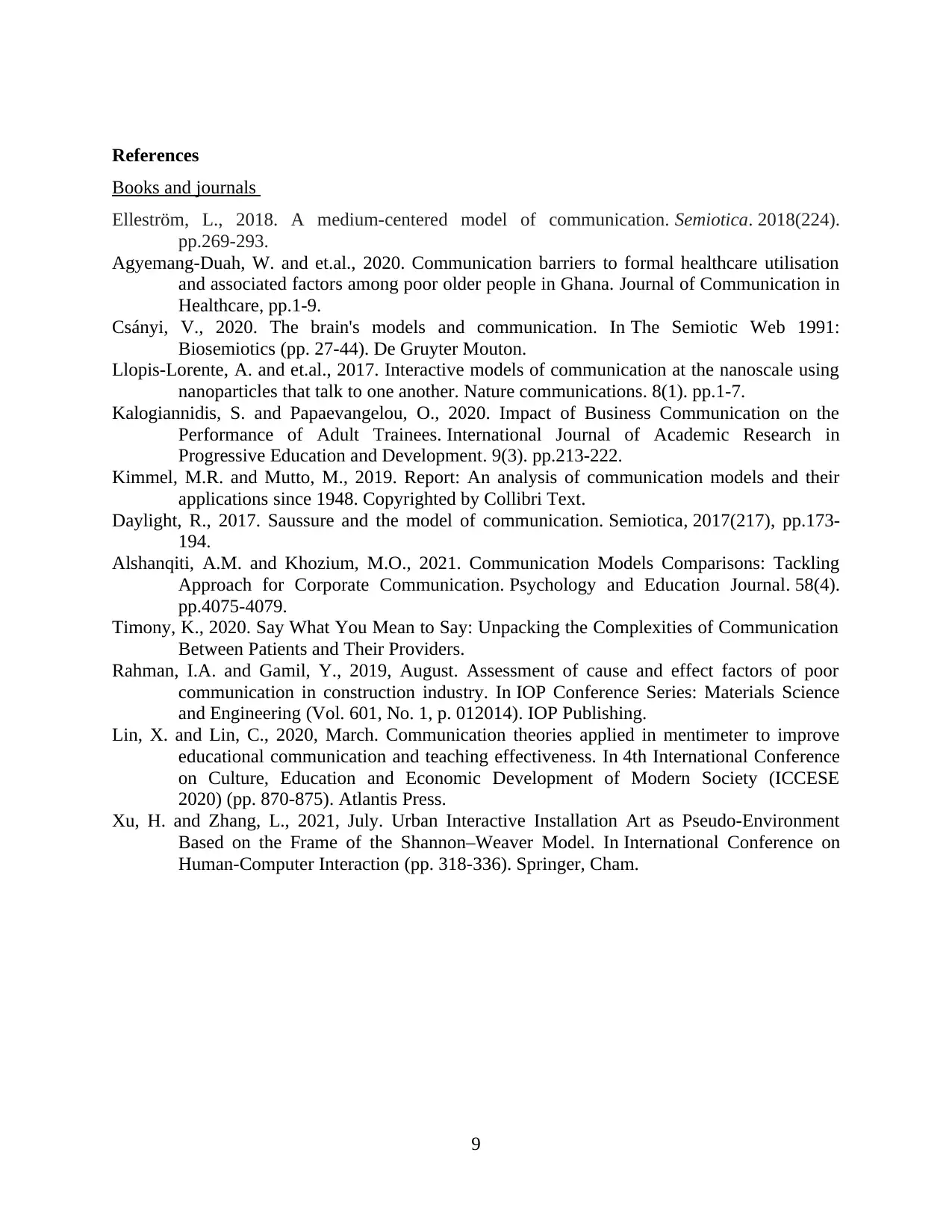
References
Books and journals
Elleström, L., 2018. A medium-centered model of communication. Semiotica. 2018(224).
pp.269-293.
Agyemang-Duah, W. and et.al., 2020. Communication barriers to formal healthcare utilisation
and associated factors among poor older people in Ghana. Journal of Communication in
Healthcare, pp.1-9.
Csányi, V., 2020. The brain's models and communication. In The Semiotic Web 1991:
Biosemiotics (pp. 27-44). De Gruyter Mouton.
Llopis-Lorente, A. and et.al., 2017. Interactive models of communication at the nanoscale using
nanoparticles that talk to one another. Nature communications. 8(1). pp.1-7.
Kalogiannidis, S. and Papaevangelou, O., 2020. Impact of Business Communication on the
Performance of Adult Trainees. International Journal of Academic Research in
Progressive Education and Development. 9(3). pp.213-222.
Kimmel, M.R. and Mutto, M., 2019. Report: An analysis of communication models and their
applications since 1948. Copyrighted by Collibri Text.
Daylight, R., 2017. Saussure and the model of communication. Semiotica, 2017(217), pp.173-
194.
Alshanqiti, A.M. and Khozium, M.O., 2021. Communication Models Comparisons: Tackling
Approach for Corporate Communication. Psychology and Education Journal. 58(4).
pp.4075-4079.
Timony, K., 2020. Say What You Mean to Say: Unpacking the Complexities of Communication
Between Patients and Their Providers.
Rahman, I.A. and Gamil, Y., 2019, August. Assessment of cause and effect factors of poor
communication in construction industry. In IOP Conference Series: Materials Science
and Engineering (Vol. 601, No. 1, p. 012014). IOP Publishing.
Lin, X. and Lin, C., 2020, March. Communication theories applied in mentimeter to improve
educational communication and teaching effectiveness. In 4th International Conference
on Culture, Education and Economic Development of Modern Society (ICCESE
2020) (pp. 870-875). Atlantis Press.
Xu, H. and Zhang, L., 2021, July. Urban Interactive Installation Art as Pseudo-Environment
Based on the Frame of the Shannon–Weaver Model. In International Conference on
Human-Computer Interaction (pp. 318-336). Springer, Cham.
9
Books and journals
Elleström, L., 2018. A medium-centered model of communication. Semiotica. 2018(224).
pp.269-293.
Agyemang-Duah, W. and et.al., 2020. Communication barriers to formal healthcare utilisation
and associated factors among poor older people in Ghana. Journal of Communication in
Healthcare, pp.1-9.
Csányi, V., 2020. The brain's models and communication. In The Semiotic Web 1991:
Biosemiotics (pp. 27-44). De Gruyter Mouton.
Llopis-Lorente, A. and et.al., 2017. Interactive models of communication at the nanoscale using
nanoparticles that talk to one another. Nature communications. 8(1). pp.1-7.
Kalogiannidis, S. and Papaevangelou, O., 2020. Impact of Business Communication on the
Performance of Adult Trainees. International Journal of Academic Research in
Progressive Education and Development. 9(3). pp.213-222.
Kimmel, M.R. and Mutto, M., 2019. Report: An analysis of communication models and their
applications since 1948. Copyrighted by Collibri Text.
Daylight, R., 2017. Saussure and the model of communication. Semiotica, 2017(217), pp.173-
194.
Alshanqiti, A.M. and Khozium, M.O., 2021. Communication Models Comparisons: Tackling
Approach for Corporate Communication. Psychology and Education Journal. 58(4).
pp.4075-4079.
Timony, K., 2020. Say What You Mean to Say: Unpacking the Complexities of Communication
Between Patients and Their Providers.
Rahman, I.A. and Gamil, Y., 2019, August. Assessment of cause and effect factors of poor
communication in construction industry. In IOP Conference Series: Materials Science
and Engineering (Vol. 601, No. 1, p. 012014). IOP Publishing.
Lin, X. and Lin, C., 2020, March. Communication theories applied in mentimeter to improve
educational communication and teaching effectiveness. In 4th International Conference
on Culture, Education and Economic Development of Modern Society (ICCESE
2020) (pp. 870-875). Atlantis Press.
Xu, H. and Zhang, L., 2021, July. Urban Interactive Installation Art as Pseudo-Environment
Based on the Frame of the Shannon–Weaver Model. In International Conference on
Human-Computer Interaction (pp. 318-336). Springer, Cham.
9
1 out of 10
Related Documents
Your All-in-One AI-Powered Toolkit for Academic Success.
+13062052269
info@desklib.com
Available 24*7 on WhatsApp / Email
![[object Object]](/_next/static/media/star-bottom.7253800d.svg)
Unlock your academic potential
© 2024 | Zucol Services PVT LTD | All rights reserved.





